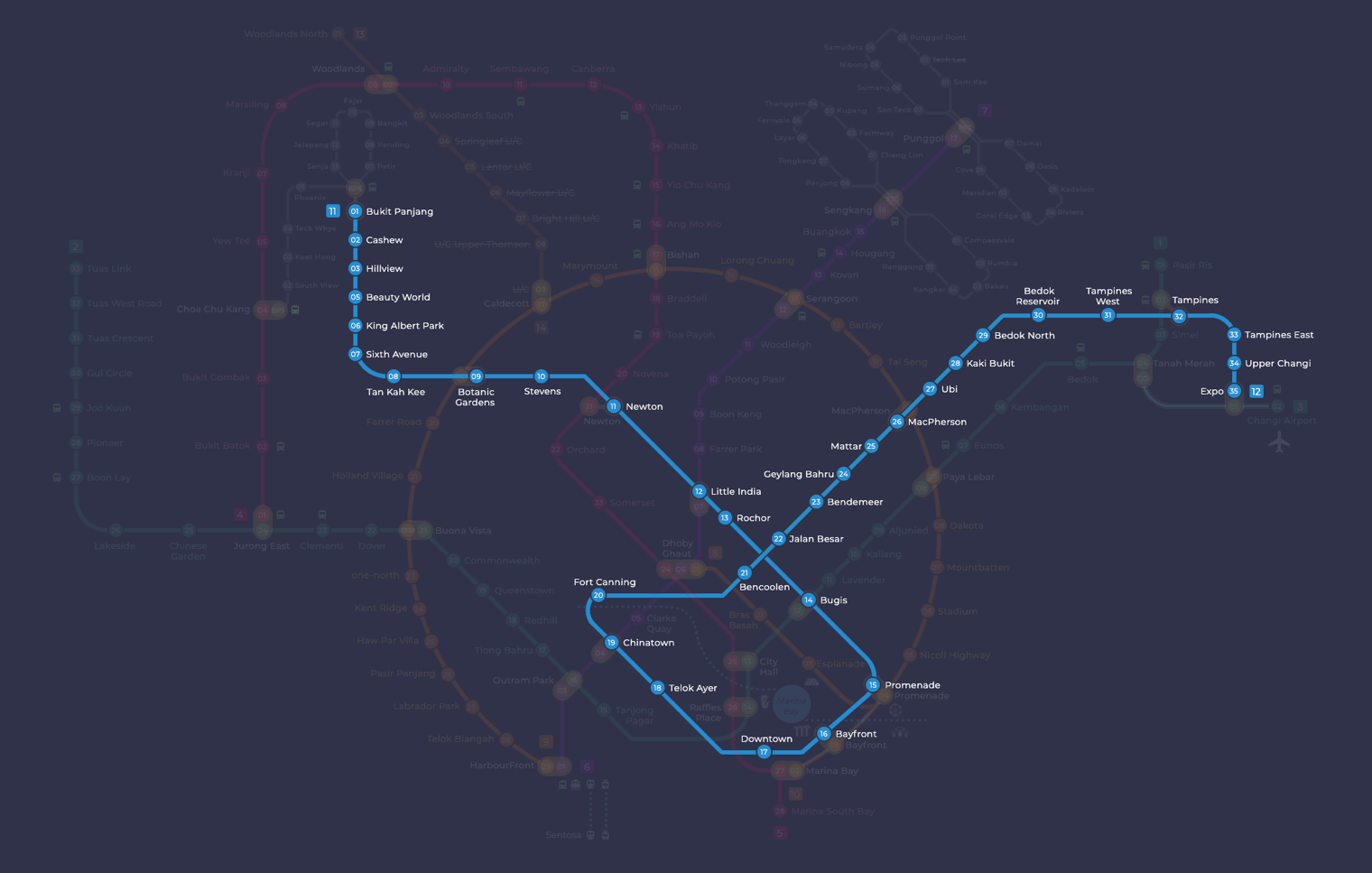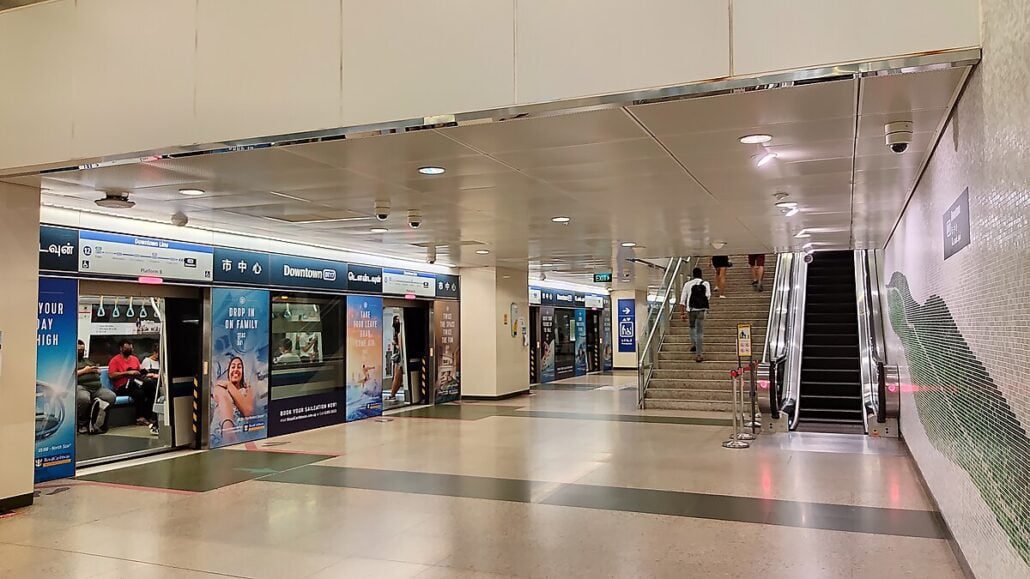Downtown Line
Expo to Bukit Panjang
View the Downtown Line in full screen at Google.
Highlighted Downtown Line Map Singapore

View the Downtown Line in full screen at Google.

Singapore is famous for its efficient, clean, and island-wide coverage of public transportation. The Downtown Line (DTL) is one of the newest and most important links in the MRT( Mass Rapid Transit ) rail network in the city-state of Singapore. In this ultimate guide to the Downtown Line, we cover everything you have ever wanted to know about it, including its history and how DTL has changed our public transport landscape in Singapore.
Singapore — The Downtown Line (DTL) is one of the most critical MRT lines in Singapore, for it serves as a rapid transit corridor that transverses through the island from northwest to East. The DTL is the longest fully underground and driverless MRT Line Singapore, making it essential to daily commuters living or working along its alignment as well as travellers. This not only significantly shortens travel time across the city, but it also links several key economic clusters as well as educational and residential areas in Singapore to one another.
The Downtown Line The idea for the Downtown link was conceived in the late 1990s when Singapore’s Land Transport Authority (LTA) mooted the development of new MRT Stations in Singapore to complement serve expanding population and growing new urban developments. It was designed as an alternative to other existing lines, especially for residents of the northwest and East, who commute from home to downtown.
Initially, it was suggested that a corridor that combines the Bukit Timah Line with the Eastern Region Line serve both residential neighbourhoods and commercial hubs. The idea would eventually become the Downtown Line.
The Downtown Line was constructed in three phases:
Building the Downtown Line was a task not without its own set of obstacles. Constructing a dedicated line, fully underground in the middle of such a dense urban environment as Singapore, involves extreme intricacy and sophisticated engineering. This was due to challenges associated with land acquisitions, tunnelling in areas of difficult geological conditions, and marrying a new line seamlessly into the existing MRT network.
Despite these issues, the Downtown Line marked several firsts on Singapore’s MRT network. It was the first line to be fitted with platform screen doors at all stations, designed for safety reasons and intended to prevent passengers from falling onto tracks accidentally. Furthermore, advanced automated train operations implemented have raised the benchmark for efficiency and reliability in the network.
The 42-km Downtown Line is the longest underground and driverless MRT line in Singapore, connecting residents to offices across all corners of the island. This line, colour-coded blue on the Singapore Mrt Map, traverses a broad assortment of neighbourhoods, business districts, and recreational areas.
To reduce the travelling time of commuters between the northwest and eastern regions, one of the biggest achievements of Downtown Line. Before the completion of DTL, residents from Bukit Panjang and Tampines were required to change multiple lines before reaching CBD. This direct and seamless connectivity of the DTL will significantly cut down travelling time, resulting in more convenient daily commutes for many.
Previously, for instance, from Bukit Panjang to Chinatown by rail needed more than an hour and included several instances of transfers — but the same trip now takes just half an hour on a service provided by DTL.
Downtown Line is also the main backbone that connects several townships throughout Singapore. It connects established residential areas with new developments, offering residents better access to employment centres, educational institutions, and recreational facilities. The line also increases the connection of various parts of town with higher social and economic integration.
Notably, the DTL has helped to greatly shorten journey times between Bukit Timah (where some top schools and nature parks are) and Tampines in the East — a major suburban residential/commercial centre.
The Downtown Line has improved connectivity for those with disabilities and the elderly as well. The barrier-free features at all stations on the DTL, like lifts and ramps with tactile guidance systems to help commuters find their way around easily, provide step-free access for everyone. Its new trains of a standard design also boast spacious interiors, very modern with requested seating and provision for wheelchairs, making its services once again stronger.
The Downtown Line is Singapore’s third “driverless” and fully automated rapid transit line, after the North-East Line (NEL) and the Circle Line. The use of the automatic train operations system ensures more accurate and reliable control over train speed, scheduling plans as well and safety barriers, hence leading to increased efficiency. The system also allows the line to operate more frequently during rush hours, which ultimately means less time spent waiting for passengers.
Driverless trains are supervised and controlled by the command centre, which monitors all train services to manage line operations with real-time information. The technology ensures that the Downtown Line provides high service levels and safety at all times, especially during peak periods.
As part of Singapore’s dedication to sustainability, the Downtown line is built with several green features. The stations are oriented to get the most amount of natural light and ventilation, which means less dependence on artificial lighting & air conditioning. The line uses energy-efficient systems (with the trains themselves even recapturing braking atoms with regenerative braking to reuse during deceleration).
The DTL also includes eco-design features, such as rainwater harvesting systems that collect water for irrigation of plants and washing at stations. While these measures will help reduce the environmental burden of the line, they also improve sustainability across Singaporeʼs public transport system.
The Downtown Line stations were also designed to fuse form with function, reflecting how Singapore approaches design and architecture. Every station has been designed in a completely different way, and each is based on the local flora or history. For example:
These design aspects not only add to the visual imagery of stations but also create a better travelling experience for commuters, engaging them more closely.

Like all new lines in Singapore, the Downtown Line was designed with passenger-friendliness in mind. There is abundant use of helpful signage indicating where to head for train services, and interchanges between (and through) MRT lines are straightforward. Each station is accompanied by several entry and exit points, which help people commute from one part to other parts in the vicinity easily. Further, within the city, ease of travel is increased further by how well-connected Circle Line stations are with other MRT lines and bus services — allowing commuters to transfer between modes quickly.
The Downtown Line has excellent accessibility incorporated in its design, making it user-friendly to all commuters regardless of their physical abilities. Beyond barrier-free access, the DTL also boasts tactile guidance systems for the visually impaired, as well as audio announcements and visual displays that give commuters real-time updates on train arrivals information and service alerts.
Paul Gallay / Streets blog NYC The trains themselves are designed with wide doors and aisles to allow for straightforward boarding of people in wheelchairs, as well as those travelling with strollers. A special space is also provided for the elderly, pregnant, and physically challenged so that all can have an enjoyable ride.
One of the key priorities for the Downtown Line team is safety. Every station has platform screen doors, preventing unwarranted expeditions to the tracks and protecting against unwanted temperatures inside stations. A full CCTV system runs on all trains, with emergency communication buttons available for passengers to alert staff if there are any problems.
Additionally, the DTL is equipped with a comprehensive fire safety system, including smoke detectors and firefighting apparatus, at strategic locations throughout all its stations. If anything goes wrong, procedures can be practised and ensure that everything is safe for everyone.
The Downtown Line will also extend further East to Sungei Bedok next year with the completion of DTL3 Extension (DTL3e) in 2025. The two new stations at Sungei Bedok (DT37) and Bedok South (DT36), when completed, will improve connectivity within the eastern part of Singapore. Sungei Bedok will also be an interchange with the future Thomson-East Coast Line, which adds to commuters’ travelling options.
Though the DTL3e extension is currently the only expansion that has been confirmed, talks are still in place for possible new stations further down on Mornington Crescent. These could be in the form of additional infill stations where demand, into or out-of-at peak times, is high enough or a new branch to serve an area that has triggered development. The LTA will continue to monitor population growth for additional MRT network expansions to keep the system reliable and well-connected.
The Downtown Line is a testimony of the Republic’s resolve to build an efficient public transport system. Revolutionized island travel — what used to be a slow transport system back then is now fast, convenient, and reliable, linking key residential areas with commercial centres together in minutes. With the line poised to expand and change, it is set to define more of Singapore’s cityscape for years down the track.
The Downtown Line has become more than a means of connecting the dots for commuters — it lets people travel through some of our city’s most unique and dynamic precincts. Whether a local or tourist, DTL is an indispensable dimension to our Singapore narrative and speaks of its cultural endeavours, past and future.
Knowing the backstory of the Downtown Line is as important in understanding how the line serves significant value to urban Singapore. Be it a routine daily journey or getting to know the city for the first time, DTL offers immersive and hassle-free commuting, which truly reflects Singapore’s identity in this new age.